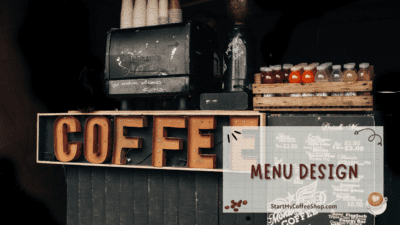In the bustling world of entrepreneurship, opening a coffee shop is a popular and overwhelming endeavor. However, like any business, it requires careful planning and execution to turn your love for coffee into a thriving venture.
A start-up business plan for a coffee shop covers essential aspects such as market analysis, target audience, location selection, menu design, marketing strategies, and financial projections. You can set your coffee shop on the path to betterment if you have a well-thought-out business plan.
This article presents the factors to be considered in creating a startup business plan for a coffee shop.
Market Analysis
Start by examining the local demographics in your area of interest. Consider factors such as age, income level, occupation, and lifestyle preferences. Understanding your potential customers’ characteristics and preferences allows you to tailor your offerings to meet their specific needs.

Next, delve into the existing coffee shop landscape. Identify any gaps or opportunities that you can leverage to differentiate your coffee shop from the rest. This analysis can help you carve out a unique selling proposition that sets your business apart.
Furthermore, keep a pulse on the ever-evolving coffee industry trends. Stay informed about emerging brewing techniques, specialty coffee varieties, and popular flavors. This knowledge enables you to align your menu and offerings with the current preferences of coffee enthusiasts.
By conducting a thorough market analysis, you equip yourself with the information needed to make informed decisions. It allows you to identify your target audience, refine your unique selling propositions, and position your coffee shop for a better place in a competitive market. Remember, a well-researched and tailored approach is the key to brewing your achievement in the world of coffee.
Read more about: How to Start a Coffee Shop Business Plan: Factors That You Need to Consider
Define Your Target Audience
Consider the different segments within the coffee-loving community. Are you targeting busy professionals who crave a quick caffeine fix on their way to work? If so, your coffee shop could focus on efficiency, offering convenient to-go options and a streamlined ordering process.
Alternatively, are you aiming to attract students seeking a cozy study space? In this case, your coffee shop can provide ample seating, comfortable lighting, and a welcoming atmosphere conducive to productivity. Offering free Wi-Fi and a variety of caffeinated and non-caffeinated beverages would also be appealing to this group.
Perhaps your coffee shop’s focus is on catering to coffee enthusiasts who are eager to explore specialty brews and unique flavors. In this scenario, you could offer a diverse range of single-origin beans, brewing methods like pour-over or cold brew, and expertly trained baristas who can guide customers through the flavor profiles and nuances of different coffees.
Defining your target audience’s demographics, psychographics, and behaviors allows you to align your coffee shop with their preferences and desires. By tailoring your offerings and ambiance to meet their specific needs, you create a coffee shop experience that resonates with your target audience, fostering loyalty and establishing a strong customer base.
Location Selection
First and foremost, assess the foot traffic in the potential location. Look for areas with high pedestrian activity, such as busy streets, shopping centers, or areas near public transportation hubs. A steady flow of people passing by increases the chances of attracting potential customers.
Proximity to offices, universities, and residential areas is another critical factor. Consider the demographics of these locations and how they align with your target audience. Being conveniently located near these places can make your coffee shop a popular destination for professionals seeking a caffeine boost, students looking for study breaks, or locals seeking a cozy spot.
Accessibility and parking availability should also be taken into account. Ensure that your location is easily accessible by both pedestrians and vehicles. Sufficient parking spaces nearby can encourage customers to visit, especially if they plan to stay longer or make purchases in bulk.
Studying the competition in the area is essential. Assess the number of existing coffee shops and their offerings. This analysis will help you determine if the market is saturated or if there are specific gaps that you can fill with your unique selling propositions.
Menu Design

Your menu serves as a reflection of your coffee shop’s identity and can be a powerful tool to attract and retain customers. To craft a captivating menu, it’s important to offer a diverse range of options that cater to different tastes and preferences.
Start by including classic coffee choices that are beloved by many. Espresso, cappuccino, and latte are timeless favorites that should find a place on your menu. These staple beverages serve as the foundation of any coffee shop and appeal to a broad customer base.
To stand out and create a unique selling proposition, consider incorporating specialty brews with distinctive flavors. Experiment with single-origin beans, different brewing methods, and innovative flavor combinations. These special offerings will intrigue coffee enthusiasts and provide them with an exciting and memorable experience.
Remember to cater to customers who may not prefer coffee by including non-coffee alternatives. Herbal teas, hot chocolate, and cold beverages like iced teas or fruit-infused drinks can be excellent options. Providing a variety of choices ensures that everyone can find something they enjoy and encourages repeat visits from customers who may have different beverage preferences.
Read more about: How to Start a Coffee Business: From a Coffee Lover to a Business Owner
Interior Design and Atmosphere
Crafting an inviting and comfortable atmosphere within your coffee shop is a vital aspect of attracting and retaining customers. Every detail, from the interior design to the furniture and lighting, contributes to the overall ambiance and customer experience. When designing your coffee shop’s atmosphere, it’s essential to consider the preferences of your target audience and create a space that resonates with them.
Start by selecting an interior design theme or style that aligns with your target audience’s tastes and preferences. Whether it’s a cozy nook with bookshelves and warm lighting for those seeking a quiet and relaxing environment, modern minimalism with sleek furniture for a contemporary and trendy feel, or a rustic aesthetic with natural elements for a cozy and welcoming vibe, ensure that the chosen theme reflects the experience you want to provide.
Pay attention to the furniture and seating arrangements as well. Choose comfortable and functional furniture that encourages customers to linger and enjoy their coffee. Provide a mix of seating options, including cozy armchairs, communal tables for group gatherings, and bar-style seating for solo customers.
The right ambiance is significantly influenced by lighting. Consider a combination of natural light during the day and warm, soft lighting in the evening to create a cozy and welcoming atmosphere. Adequate lighting not only enhances the overall ambiance but also creates a visually pleasing environment for customers.
Ultimately, the goal is to create an atmosphere that makes customers feel comfortable, relaxed, and eager to spend time in your coffee shop. By carefully curating the interior design, furniture, lighting, and overall ambiance, you can create a space that becomes a destination for coffee lovers, fostering a sense of loyalty and a desire to return for more than just a cup of coffee.
Marketing and Promotion
Implementing a well-executed marketing strategy is crucial for generating buzz and attracting customers to your coffee shop. To effectively reach your target audience, it’s important to leverage a combination of online and offline marketing channels.
Start by establishing a strong online presence through social media platforms such as Instagram, Facebook, and Twitter. Share visually appealing photos of your coffee offerings, engage with your audience through interactive posts, and respond to customer inquiries and feedback promptly. Additionally, create a user-friendly website that showcases your coffee shop’s unique selling points, menu, location, and contact information.
Collaborating with local influencers can be a powerful way to reach a wider audience. Partner with influencers who have a significant following and align with your coffee shop’s brand. They can promote your coffee shop through sponsored content, giveaways, or reviews, increasing visibility and driving traffic to your establishment.
Organizing tasting events or offering discounts and promotions can help create excitement and attract new customers. Consider hosting coffee cupping sessions or themed events to showcase the quality and flavors of your offerings. Discounts during off-peak hours or special promotions for loyal customers can also encourage repeat business.
Implementing a loyalty program is an effective strategy for building a loyal customer base. Offer incentives such as discounts, freebies, or exclusive access to new menu items. This encourages customers to return and promotes word-of-mouth recommendations.
Staffing and Training

The popularity of your coffee shop depends greatly on the caliber of your staff. It is crucial to hire skilled baristas who possess a genuine passion for coffee and a commitment to providing exceptional customer service.
Additionally, investing in comprehensive training programs ensures consistency in brewing techniques, customer interactions, and product knowledge. By equipping your staff with the necessary skills and knowledge, you create a team that can deliver a consistently excellent customer experience.
A knowledgeable and friendly staff not only enhances the quality of your coffee offerings but also fosters a welcoming environment that encourages customer loyalty and repeat business.
Read more about: How to Start a Business Plan for a Coffee Shop: The Art of Brewing Business
Financial Projections
To ensure the long-term sustainability of your coffee shop, it is essential to develop a robust financial plan. Start by estimating the initial investment required, which includes expenses like equipment, interior design, licensing, and inventory. Carefully calculate the cost of goods sold (COGS), overhead expenses, and operational costs such as rent, utilities, and salaries.
Conducting a detailed sales forecast based on your market analysis and understanding your target audience is crucial. Project your revenue based on factors like foot traffic, customer demand, and pricing strategy. It is important to ensure that your projected revenue not only covers your expenses but also allows for growth and profitability.
By developing a solid financial plan, you gain a clear understanding of the financial feasibility of your coffee shop. It helps you make informed decisions, set realistic goals, and monitor your financial performance. With a well-designed financial plan, you increase your chances of running a sustainable coffee shop in the long run.
Summary
Remember, the key to standing out in the competitive coffee industry lies in offering an exceptional customer experience, from the first sip to the last drop. So grab that espresso shot of inspiration and embark on your entrepreneurial journey to brew greatness in the world of coffee.
Frequently Asked Questions

Q: How do I determine the target audience for my coffee shop?
A: To determine your target audience, consider factors such as demographics, psychographics, and behaviors. Analyze local demographics and identify consumer preferences to tailor your coffee shop experience accordingly.
Q: What should I include in my coffee shop menu?
A: A well-rounded menu should include a variety of coffee options, both classic and specialty brews. Consider incorporating non-coffee alternatives like teas and hot chocolate. Additionally, offer a selection of pastries, sandwiches, and snacks to complement the coffee experience.
Q: How important is the location of a coffee shop?
A: Choose a location with high foot traffic, proximity to offices or universities, and good accessibility. Assess the competition in the area to identify market gaps you can fill.
To learn more on how to start your own coffee shop, check out my startup documents here.
Disclaimer: The information provided by StartMyCoffeeShop.com (“The Site”) is for general informational purposes only. All information on the Site is provided in good faith. However, we make no representation or warranty of any kind, express or implied, regarding the accuracy, adequacy, validity, reliability, availability, or completeness of any information on the Site. Under no circumstance shall we have any liability to you for any loss or damage of any kind incurred as a result of the use of the Site or Reliance on any information provided on the Site. Your use of the Site and reliance on any information on the Site is solely at your own risk. This blog post is for educational purposes only and does not constitute legal advice. Please consult a legal expert to address your specific needs. Terms and Conditions. (https://startmycoffeeshop.com/terms-and-conditions/)

Hi! I’m Shawn Chun
My adventure in coffee began when I first launched my first coffee shop back in the early 2000s. I had to figure out so many things on my own and to make it worse within 2 years of opening two large corporate coffee chains moved in just blocks away from me!
As I saw smaller and even some larger coffee shops in the neighborhood slowly lose customers to these giant coffee chains and slowly close up shop, I knew that I had to start getting creative…or go out of business.
I (like you may be) knew the coffee industry well. I could make the best latte art around and the foam on my caps was the fluffiest you have ever seen. I even had the best state-of-the-art 2 group digital Nuova Simonelli machine money could buy. But I knew that these things alone would not be enough to lure customers away from the name brand established coffee shops.
Eventually, through lots of trial and error as well as perseverance and creativity I did find a way to not only survive but also thrive in the coffee/espresso industry even while those corporate coffee chains stayed put. During those years I learned to adapt and always faced new challenges. It was not always easy, however, in the end, I was the sole survivor independent coffee shop within a 10-mile radius of my location. Just two corporate coffee chains and I were left after that year. All told the corporate coffee chains took down over 15 small independent coffee shops and kiosks and I was the last one standing and thriving.
Along the years I meet others with the same passion for coffee and I quickly learned that it is not only “how good a barista is” that makes a coffee shop successful, but the business side of coffee as well.
Hence why I started this website you are on now. To provide the tools and resources for up and coming coffee shop owners to gain that vital insight and knowledge on how to start a coffee shop successfully.
Stick around, browse through my helpful blog and resources and enjoy your stay! With lots of LATTE LOVE!
Shawn







